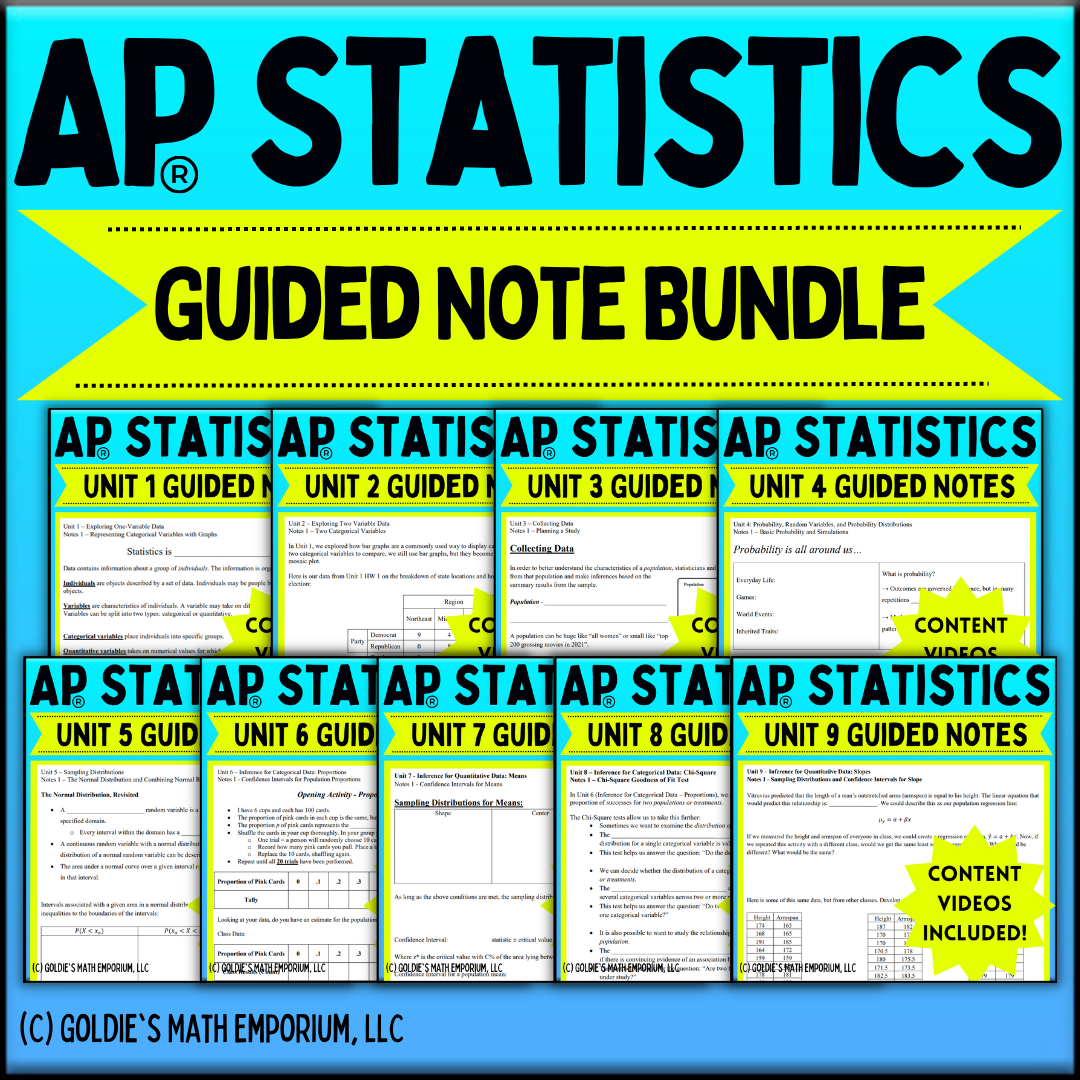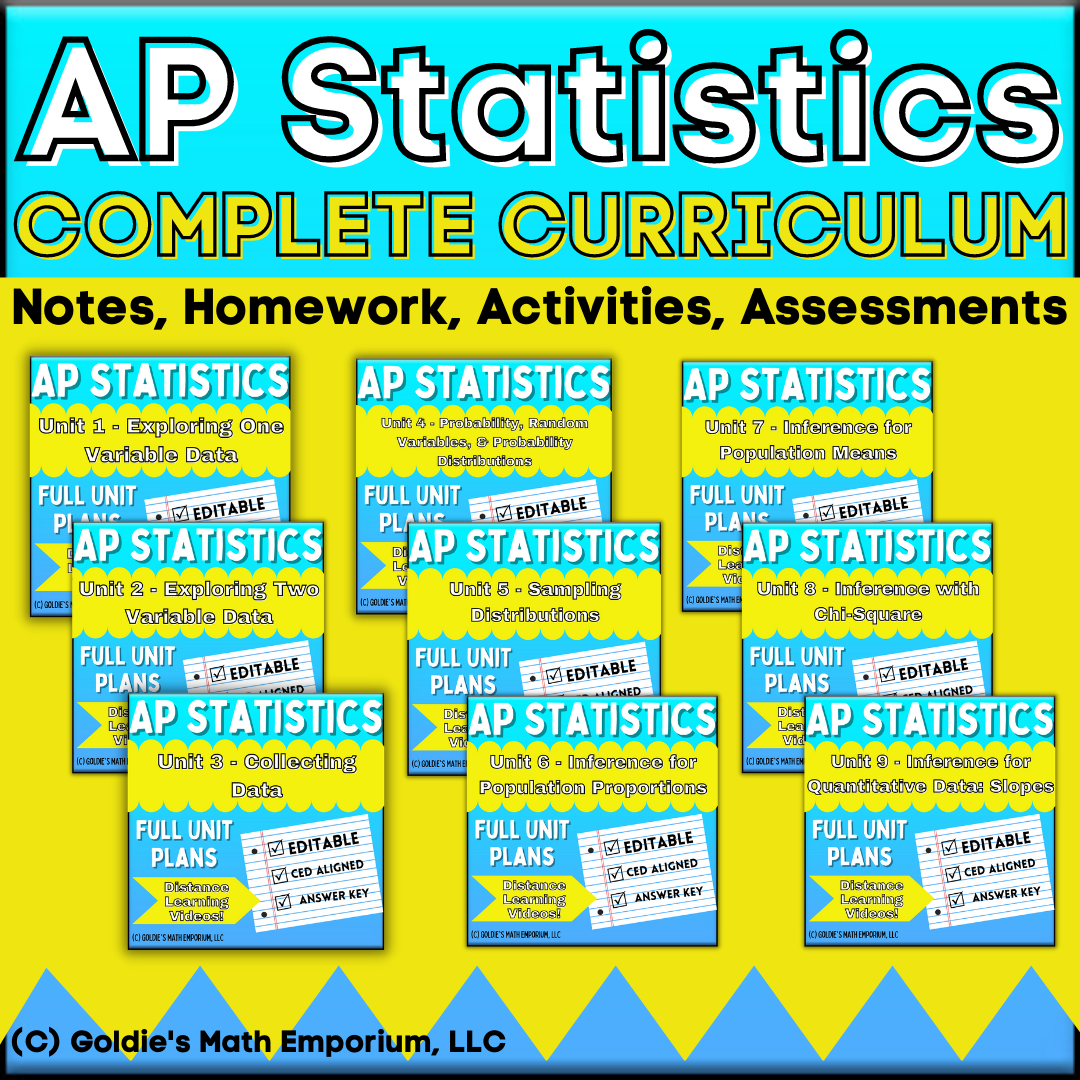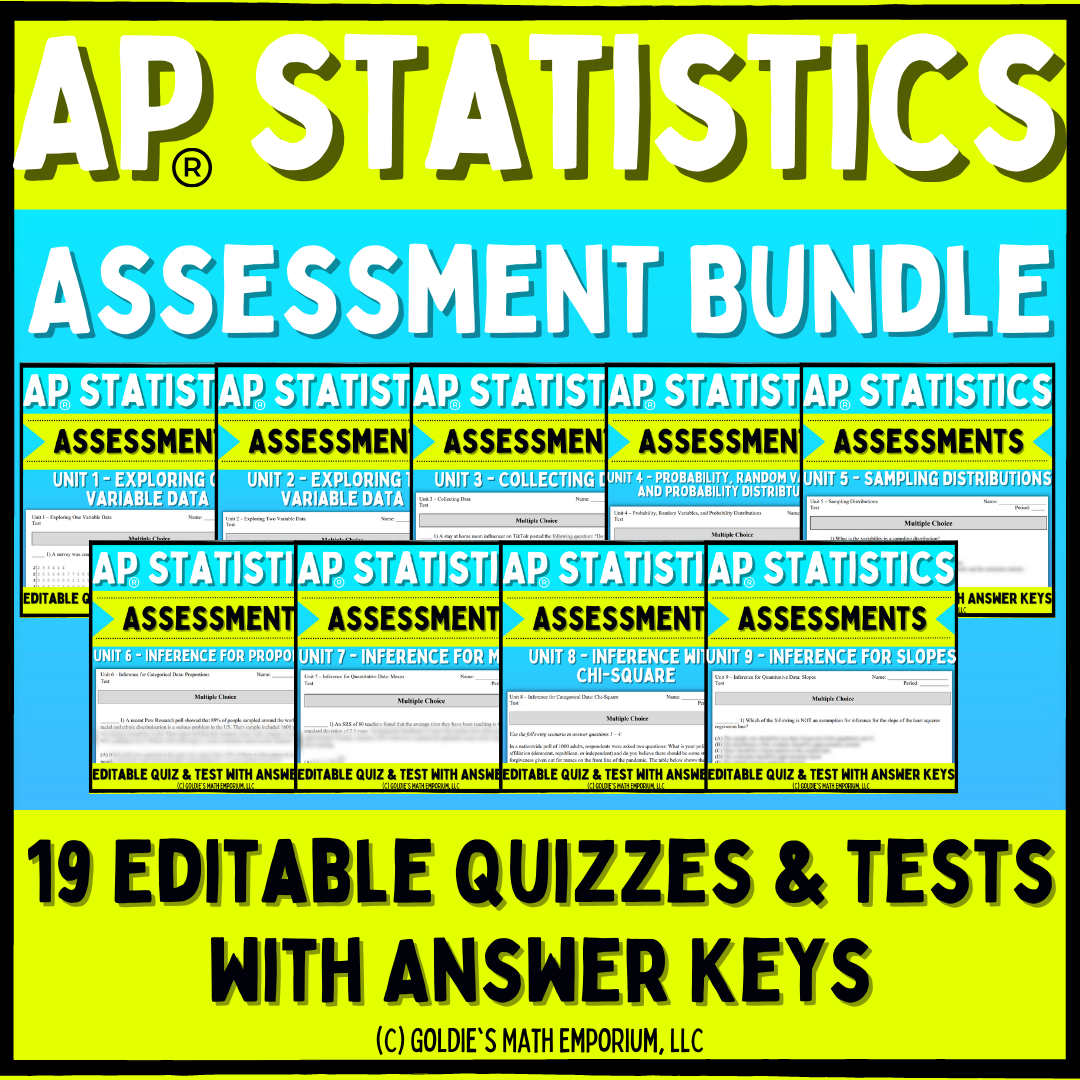Welcome to Goldie’s blog! I want to take you through my thoughts on teaching Unit 6 – Inference for Categorical Data: Proportions in my AP Statistics classroom. I want to talk briefly about the “traditional” way of teaching statistical inference and comment on the redesign of the CED. Then I will walk you through my content introduction and follow up with some pacing comments. I hope you find something useful for your own classroom!

Traditional Sequence
When I first started teaching AP Statistics, before the CED guidelines, the sequence of the content looked similar to this:
- Unit 6: Confidence Intervals
- Unit 7: Hypothesis Testing
- Unit 8: Two-Proportion Inference
- Unit 9: Chi-Square Inference
- Unit 10: Regression Inference
Previously, you would teach all the confidence interval material right away. You would start off with confidence intervals for proportions, and then move into confidence intervals for means, and then two proportion and two sample confidence intervals. While I really didn’t mind this when I was teaching it (it made sense, after all, to teach everything about confidence intervals together), I love the redesign of the CED to the following:
- Unit 6: Inference for Proportions
- Unit 7: Inference for Means
- Unit 8: Chi-Square Inference
- Unit 9: Regression Inference
One of the biggest problems I had, when teaching all confidence interval material together, was students getting really confused about the conditions and test statistics between proportions and means. They understood when to use what in each problem. Still, the second they had to verify conditions, I had some students using the CLT as a condition for proportions, some students trying to use a t* when they were making an interval to capture a population proportion, and more mix-ups like this. They usually get it by test time but it really felt like a mess those first few days of teaching it. I thought this was normal UNTIL I taught all of the inferences for proportions together, and then I really saw an understanding click!
In Unit 6, Inference for Proportions, students will first learn about a confidence interval, and how we use it to capture the true population proportion with a varying degree of confidence. Then we move right into hypothesis testing for proportions in the next set of notes. While this, at first, seems to be two huge concepts squished together in a single week, I really love how the students are able to hang onto those conditions needed between the two inference procedures. Besides that, they are working with proportions in every problem, so they can really learn to handle those well without having to make the decision yet about choosing inference procedures.
What is also really powerful is in Notes 4, the connection between confidence intervals and hypothesis testing is introduced early. Before this sequence, I always felt like that powerful connection was lost. The last set of notes teaches confidence intervals and hypothesis testing for two proportions, which again, being all in the same unit, I really felt like students can grasp the reason behind the formulas and conditions a lot better than they could when it was taught at towards the end of the sequence before 2020.
Notes 1 – Confidence Interval for Proportions
I always like starting off this set of notes with the same activity we did in Unit 5 – the proportion of pink cards. In Unit 5, we did this activity knowing that the population proportion of pink cards was 0.5. Now, I tell students that they will not know the population proportion of pink cards and they will repeat the same activity trying to estimate what that mystery proportion is.
Here is what my setup looks like! I have six groups and make a cup of 100 cards for each group.

There are 30 blue cards and 70 pink cards (0.7 is my mystery proportion, but the students don’t know that).
They will shuffle the cards and draw ten without replacement:

They will record the proportion of pink cards in their sample of 10 and record it in the table.
They repeat the same task of sampling 10 cards, recording the proportion of pink cards in the sample, and then replacing them. Each person will do this 20 times. Then we compile the class data and create a graph and measure the summary statistics. This is what students will end up seeing (this is from one of my previous class results):

What is really cool about this is students can then see the sampling distribution take shape again. They see that it is approximately normal, they can find the standard deviation using the formula, and the center of the sampling distribution is almost exactly the mystery proportion (most of the time!). From there, we recall the Empirical Rule and merge the idea of capturing the true proportion by using a confidence interval.
Notes 2 – Significance Tests for Population Proportions
At the start of this set of notes, I set up a challenge. I put a piece of tape down on the floor and then a trash can a little ways away. I choose the student that always has too much to say in class (you know the one) and I tell them to make a claim about how many shots they can make (with a piece of paper, a foam ball if you have one, or really anything you want to grab and throw into the trash). They always make a large claim (8/10, 9/10, etc), and then I razz up the class by asking them if they think this student could make it (it is always a resounding “no” from the student body).
That gives us two claims to test: p = 0.8 and p < 0.8. I then have the student shoot the object into the trash can 10 times. From this, we get the sample proportion. A conversation is then had about this sample proportion: which hypothesis does it support? Is there evidence that this student is not a 0.8 shooter? Could they have gotten a sample proportion like we saw but maybe they still are a 0.8 shooter?
After that, we introduce hypothesis notation, p-values, and significance levels. What is great about this, is the conditions are all the same as confidence intervals (but you use the claimed proportion to check the normal condition instead of the sample proportion), so we do not have to focus on those but rather, can really focus on how a significance test helps us answer a question about the population proportion.
Notes 3 – Errors and Power
This set of notes starts off with my favorite analogy in statistics: the courtroom analogy. Almost all of my students really understand the courtroom analogy when it comes to the idea of “innocent until proven guilty”. I like being able to tie this into hypothesis testing and talk about how errors are still made!
Notes 4 – Confidence Intervals and Significance Tests
I cover the calculator commands that students will use if they find a confidence interval or a p-value using technology. I like to do this after we have already had some good practice doing everything by hand, just so I can remind them that they should really only be using this either on a multiple-choice question or to check their work on a free-response question.
Then, we get into connecting confidence intervals and hypothesis testing and how you can use a confidence interval to conduct a two-sided hypothesis test. I love doing this because for me, any time I can connect ideas in math, I get all warm and fuzzy.
Notes 5 – Comparing Two Proportions
As I mentioned above, I like doing two proportions in this unit, and not at the end, because after using all the formulas for proportions, it isn’t too much of a stretch for students to see how to bring two proportions together. We will review how to combine random variables again, and they will see that it is just those ideas we use to create these new formulas. The conditions are the same as they have always been (just checked twice, essentially). The only “new” thing would be the pooled proportion when conducting significance testing for two proportions, but students have handled this really well since switching to the new sequence.
Pacing of Unit 6
Whenever I get into Unit 6, I always wish I had a few more days to practice some multiple-choice questions. I think the homework does a great job of it, but at this point in the year, I just don’t have time to dedicate a few days to that. I try to get through this unit before February, if I was on track with everything else. We haven’t had any snow or cold days that have significantly impacted our year yet, so the pacing is actually looking pretty good! There was one year where we lost 7 school days in January, and it threw me off all the way until exam time. An AP teacher’s worst nightmare!
Luckily, if you do get behind, remember that you have the guided note videos that you can assign outside of class to help students get caught up. As much as I hate to say it too, you can always cut out the activities as well to try and get back on pace. Between you and me, however, I would sooner give a take home quiz than cut out an activity.
I hope you were able to take away some great things to help you teach Unit 6! Getting into confidence intervals and significance testing is so exciting and I wish you all the best. Always reach out if you need any help at all.









0 Comments